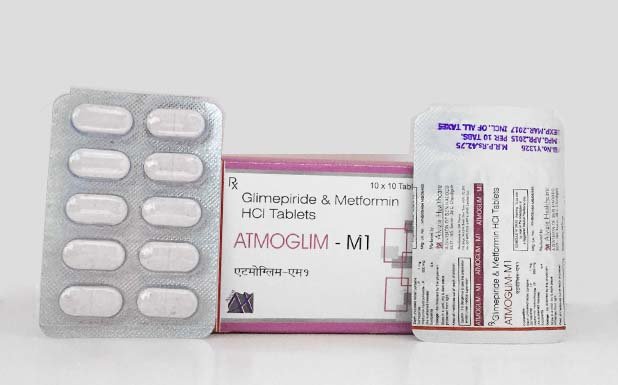Indications & Usage Type 2 diabetes (particularly in over weight patients)
Mechanism of action Metformin belongs to the class of biguanides and used in the management of type 2 diabetes mellitus. Metformin is the insulin sensitizer and reduces insulin resistance. Metformin is beneficial in obese patients. Metformin prevents the hepatic glucose production, increases the intestinal absorption of the glucose and inhibit peripheral utilization of the glucose. When administered orally, it half absorbed through intestine and it takes about 7 hours to reach maximum concentration in plasma. Presence of food decreases the absorption of metformin. When 800mg of metformin was administered, the volume of distribution was found to be 654 ± 358 L and is negligibly bound to plasma protein. Metformin is excreted in unchanged form mainly in urine and the half-life is 17.6 hours. Glimepiride stimulates the beta cells in pancreas to secrete insulin and improves the sensitivity of peripheral tissues to insulin to increase peripheral glucose uptake, thus reducing plasma blood glucose levels and glycated hemoglobin (HbA1C) levels. ATP-sensitive potassium channels in pancreatic beta cells play a role as essential metabolic sensors. When these channels are open, leading to K+ efflux from the cell, membrane hyperpolarization, and suppression of insulin secretion. Glimepiride inhibits the ATP-sensitive potassium channel by binding non-specifically to the B sites of both sulfonylurea receptor-1 (SUR1) and sulfonylurea receptor-2A (SUR2A) subunits as well as the A site of SUR1 subunit of the channel and blocks the influx of potassium ultimately promote insulin secretion from the beta cell. Glimepiride is completely absorbed through GIT and the volume of distribution was 8.8 L (113 mL/kg). The plasma protein of glimepiride was 99.5% and is mainly metabolised in liver by family of CYP enzymes. It is mainly excreted in urine and the half-life is 5 to 8 hours.
Side Effects The common side effects include nausea, vomiting, stomach upset, diarrhoea, weakness, metallic taste and dizziness.
Interaction Metformin is a cationic (positively charged) molecule and may compete with other cationic drugs for renal secretion through organic cation transporters in the kidneys. Procainamide, digoxin, quinidine, trimethoprim, and vancomycin are all cationic drugs that have the potential to interact with metformin.
A potential interaction between oral miconazole and sulfonylureas leading to severe hypoglycemia has been reported.
There may be an interaction between glimepiride and inhibitors (e.g., fluconazole) and inducers (e.g., rifampin) of cytochrome P450 2C9.
Contraindications ● Severe or advanced heart failure ● Active bladder cancer ● Diabetic ketoacidosis ● Not to be used with beta blockers
